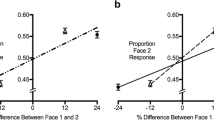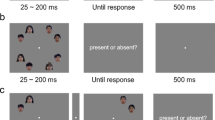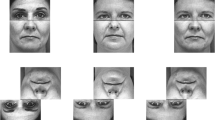Abstract
Human observers are experts at visual face recognition due to specialized visual mechanisms for face processing that evolve with perceptual expertize. Such expertize has long been attributed to the use of configural processing, enabled by fast, parallel information encoding of the visual information in the face. Here we tested whether participants can learn to efficiently recognize faces that are serially encoded—that is, when only partial visual information about the face is available at any given time. For this, ten participants were trained in gaze-restricted face recognition in which face masks were viewed through a small aperture controlled by the participant. Tests comparing trained with untrained performance revealed (1) a marked improvement in terms of speed and accuracy, (2) a gradual development of configural processing strategies, and (3) participants’ ability to rapidly learn and accurately recognize novel exemplars. This performance pattern demonstrates that participants were able to learn new strategies to compensate for the serial nature of information encoding. The results are discussed in terms of expertize acquisition and relevance for other sensory modalities relying on serial encoding.




Similar content being viewed by others
References
Boutsen L, Humphreys GW (2003) The effect of inversion on the encoding of normal and ‘thatcherized’ faces. Q J Exp Psychol 56A(6):955–975
Brainard DH (1997) The psychophysics toolbox. Spat Vis 10:433–436
Carey S, Diamond R (1977) From piecemeal to configurational representation of faces. Science 195:312–314
Collishaw SM, Hole GJ (2000) Featural and configurational processes in the recognition of faces of different familiarity. Perception 29(8):893–909
Dahl CD, Wallraven C, Bülthoff HH, Logothetis NK (2009) Humans and macaques employ similar face-processing strategies. Curr Biol 19:509–513
Dalrymple KA, Bischof WF, Cameron D, Barton JJ, Kingstone A (2010) Simulating simultanagnosia: spatially constricted vision mimics local capture and the global processing deficit. Exp Brain Res 202(2):445–455
Dalrymple KA, Birmingham E, Bischof WF, Barton JJ, Kingstone A (2011) Experiencing simultanagnosia through windowed viewing of complex social scenes. Brain Res 1367:265–277
De Gelder B, Rouw R (2000) Paradoxical configuration effects for faces and objects in prosopagnosia. Neuropsychologia 38:1271–1279
Diamond R, Carey S (1986) Why faces are and are not special: an effect of expertise. J Exp Psychol Gen 115:107–117
Dopjans L, Wallraven C, Bülthoff HH (2009) Cross-modal transfer in visual and haptic face recognition. IEEE Trans Haptics 2:236–240
Dopjans L, Bülthoff HH, Wallraven C (2012) Serial exploration of faces: comparing vision and touch. J Vis 12(1):6
Farah MJ, Wilson KD, Drain HM, Tanaka JR (1995) The inverted face inversion effect in prosopagnosia: evidence for mandatory, face-specific perceptual mechanisms. Vis Res 35(14):2089–2093
Freire A, Lee K, Symons LA (2000) The face-inversion effect as a deficit in the encoding of configural information: direct evidence. Perception 29:159–170
Gauthier I, Tarr MJ (1997) Becoming a ‘Greeble’ expert: exploring the face recognition mechanism. Vis Res 37:1673–1682
Gauthier I, Tarr MJ (2002) Unraveling mechanisms for expert object recognition: bridging brain activity and behavior. J Exp Psychol Human Learn Memory 28:432–446
Gauthier I, Williams P, Tarr MJ, Tanaka JW (1998) Training ‘greeble’ experts: a framework for studying expert object recognition processes. Vis Res 38:2401–2428
Gauthier I, Behrmann M, Tarr MJ (1999a) Can face recognition really be dissociated from object recognition? J Cognit Neurosci 11:349–370
Gauthier I, Tarr MJ, Anderson A, Skudlarski P, Gore JC (1999b) Activation of the middle fusiform ‘face area’ increases with expertise in recognizing novel objects. Nat Neurosci 2:568–573
Gold JM, Mundy PJ, Tjan BS (2012) The perception of a face is no more than the sum of its parts. Psychol Sci. doi:10.1177/0956797611427407
Hay DC, Cox R (2000) Developmental changes in the recognition of faces and facial features. Infant Child Dev 9:199–212
Hole GJ (1994) Configurational factors in the perception of unfamiliar faces. Perception 23(1):64–74
Ikeda M, Uchikawa K (1978) Integrating time for visual pattern perception and a comparison with the tactile mode. Vis Res 18:1565–1571
Jiang F, Blanz V, Rossion B (2011) Holistic processing of shape cues in face identification: evidence from face inversion, composite faces, and acquired prosopagnosia. Visual Cognit 19(8):1003–1034
Lakatos S, Marks L (1999) Haptic form perception: relative salience of local and global features. Percept Psychophys 61(5):895–908
Leder H, Bruce V (2000) When inverted faces are recognized: the role of configural information in face recognition. Q J Exp Psychol 53A:513–536
Loomis JM, Lederman SJ (1986) Tactual perception. In: Boff KR, Kaufman L, Thomas JP (eds) Handbook of perception and human performances, vol 2, cognitive processes and performance. Wiley, New York, pp 31/1–31/41
Loomis JM, Klatzky RL, Lederman SJ (1991) Similarity of tactual and visual picture recognition with limited field of view. Perception 20:167–177
Malpass RS, Lavigueur H, Weldon DE (1973) Verbal and visual training in face recognition. Percept Psychophys 14:283–292
Maurer D, LeGrand R, Mondloch CJ (2002) The many faces of configural processing. Trends Cognit Sci 6:255–260
McKone E, Kanwisher N, Duchaine BC (2006) Can generic expertise explain special processing for faces? Trends Cognit Sci 11(1):8–15
Mondloch CJ, Geldart S, Maurer D, LeGrand R (2003) Developmental changes in face processing skills. J Exp Child Psychol 86:67–84
O’Toole AJ, Vetter T, Blanz V (1999) Three-dimensional shape and two-dimensional surface reflectance contributions to face recognition: an application of three-dimensional morphing. Vis Res 39:3145–3155
Palmeri TJ, Cottrell GW (2010) Modeling perceptual expertise. In: Gauthier I, Tarr MJ, Bub D (eds) Perceptual expertise: bridging brain activity and behavior. Oxford University Press, Oxford
Pelli DG (1997) The VideoToolbox software for visual psychophysics: transforming numbers into movies. Spat Vis 10:437–442
Pellicano E, Rhodes G (2003) Holistic processing of faces in preschool children and adults. Psychol Sci 14:618–622
Reed CL, Stone VE, Bozova S, Tanaka J (2003) The body-inversion effect. Psychol Sci 14(4):302–308
Robbins R, McKone E (2003) Can holistic processing be learned for inverted faces? Cognition 88:79–107
Russell R, Biederman I, Nederhouser M, Sinha P (2007) The utility of surface reflectance for the recognition of upright and inverted faces. Vis Res 47:157–165
Schwaninger A, Wallraven C, Cunningham DW, Chiller-Glaus S (2006) Processing of identity and emotion in faces: a psychophysical, physiological and computational perspective. Prog Brain Res 156:321–343
Schwarzer G (2000) Development of face processing: the effect of face inversion. Child Dev 71:391–401
Scott LS, Tanaka J, Sheinberg DL, Curran T (2006) A reevaluation of the electrophysiological correlates of expert object processing. J Cognit Neurosci 18:1453–1465
Scott LS, Tanaka JW, Sheinberg DL, Curran T (2008) The role of category learning in the acquisition and retention of perceptual expertise: a behavioral and neurophysiological study. Brain Res 1210:204–215
Searcy JH, Bartlett JC (1996) Inversion and processing of component and spatial-relational information of faces. J Exp Psychol Hum Percept Perform 22:43–47
Sekuler AB, Gaspar CM, Gold JM, Bennett PJ (2004) Inversion leads to quantitative not qualitative, changes in face processing. Curr Biol 14(5):391–396
Sergent J (1984) An investigation into component and configural processes underlying face perception. Br J Psychol 75(2):221–242
Tanaka JW, Farah MJ (1993) Parts and wholes in face recognition. Q J Exp Psychol 12:242–248
Tanaka JW, Sengco J (1997) Features and their configuration in face recognition. Memory Cognit 25:583–592
Tarr MJ, Pinker S (1989) Mental rotation and orientation-dependence in shape recognition. Cogn Psychol 21(2):233–282
Troje NF, Bülthoff HH (1996) Face recognition under varying pose: the role of texture and shape. Vis Res 36:1761–1771
Valentine T (1988) Upside-down faces: a review of the effects of inversion upon face recognition. Br J Psychol 79:471–491
Van Belle G, De Graef P, Verfaillie K, Rossion B, Lefèvre P (2010) Face inversion impairs holistic perception: evidence from gaze-contingent stimulation. J Vis 10:1–13
Wong ACN, Palmeri T, Gauthier I (2009) Conditions for face-like expertise with objects: becoming a Ziggerin expert—but which type? Psychol Sci 20(9):1109–1117
Yin RK (1969) Looking at upside-down faces. J Exp Psychol 81:141–145
Yip A, Sinha P (2002) Role of color in face recognition. Perception 31:995–1003
Acknowledgments
This research was supported by a Ph.D. stipend from the Max Planck Society, by the World Class University (WCU) program through the National Research Foundation of Korea funded by the Ministry of Education, Science, and Technology (R31-1008-000-10008-0), and through the National Research Foundation of Korea funded by the Ministry of Education, Science, and Technology (2010-0011569).
Author information
Authors and Affiliations
Corresponding author
Rights and permissions
About this article
Cite this article
Wallraven, C., Whittingstall, L. & Bülthoff, H.H. Learning to recognize face shapes through serial exploration. Exp Brain Res 226, 513–523 (2013). https://doi.org/10.1007/s00221-013-3463-y
Received:
Accepted:
Published:
Issue Date:
DOI: https://doi.org/10.1007/s00221-013-3463-y




